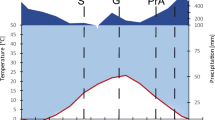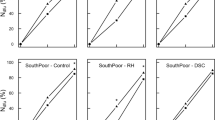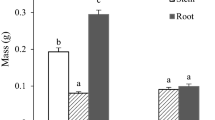Abstract
The concentrations of arginine, protein and total nitrogen (N) and the abundance of15N were measured in 3-and 4-year-old needles of Scots pine trees fertilized with either 0 (C), 36 (N1) or 73 (N2) kg N ha-1 year-1 annually for 22 years (average doses of N). Remaining green needles and needles that were shed were compared and removal of N from total, protein and arginine pools was calculated. Earlier investigations had shown that high arginine concentrations are found in needles of trees that have an excessive N supply (Näsholm and Ericsson 1990). This study aimed to elucidate the fate of the accumulated arginine during needle senescence. It was speculated that a low removal of arginine during senescence would implicate that the primary function of arginine is in N detoxification and not in N storage. Moreover, litter quality would be altered if needles are shed with high concentrations of arginine and this might affect the turnover of N in forest ecosystems. In remaining green needles, the concentration of total N increased with increasing N supply. Protein N concentrations were higher in fertilized trees, but did not differ between the two N treatments. Arginine N was low in C and N1 trees but high in N2 trees. Senescent needles from C and N1 trees had about equal total N concentrations while in N2 trees this concentration was significantly higher. Protein N in senescent needles did not differ between treatments. Arginine N, however, was less than 0.1 mg g−1 dw in C and N1 trees but was higher than 1.5 mg g−1 dw in N2 trees. Removal of N was highest in N1 trees followed by C trees while N2 trees removed least N from senescing needles. The high concentration of total N in senescent needles from N2 trees was to a great extent explained by a high arginine concentration.
The δ15N value of remaining, green needles was higher (less negative) in N2 trees than in C and N1 trees. The same pattern was found for senescent needles. Comparisons of δ15N values between remaining, green and senescent needles within each treatment showed a significant increase in δ15N for all treatments during senescence possibly indicating losses of N as NH3 (g) from needles during senescence. It is concluded that arginine, accumulated in response to high N supply, is retranslocated only to a small extent during needle senescence. The ecological and physiological implications of this finding are discussed.
Similar content being viewed by others
References
Aronsson A (1988) Indications of stress at unbalanced nutrient contents of spruce and pine (English summary). K Skogs-Lantbruksakad Tidskr Suppl 17: 40–51
Barrie A, Lemley M (1989) Automated N-15/C-13 analysis of biological materials. Int Lab Tech 19: 82–91
Chapin FS III (1980) The mineral nutrition of wild plants. Annu Rev Ecol Syst 11: 233–260
Chapin FS III, Kedrowski RA (1983) Seasonal changes in nitrogen and phosphorus fractions and autumn retranslocation in evergreen and deciduous taiga trees. Ecology 64: 376–391
Dijk HFG van, Roelofs JGM (1988) Effects of excessive ammonium deposition on the nutritional status and condition of pine needles. Physiol Plant 73: 494–501
Edfast A-B, Näsholm T, Ericsson A (1990) Free amino acids in needles of Norway spruce and Scots pine trees on different sites in areas with two levels of nitrogen deposition. Can J For Res 20: 1132–1136
Farquhar GD, Wetselaar R, Firth PM (1979) Ammonia volatilization from senescing leaves of maize. Science 203: 1257–1258
Farquhar GD, Wetselaar R, Weir B (1983) Gaseous nitrogen losses from plants. In: Freeny JR, Simpson JR (eds) Gaseous losses from plant-soil systems (Developments in Plant and Soil Sciences vol 9). Nijhoff, The Hague, pp 159–181
Flanagan PW, Van Cleve K (1983) Nutrient cycling in relation to decomposition and organic-matter quality in taiga ecosystems. Can J For Res 13: 795–817
Gebauer G, Schulze E-D (1991) Carbon and nitrogen isotope ratios in different compartments of a healthy and a decliningPicea abies forest in the Fichtelgebirge, NE Bavaria. Oecologia 87: 198–207
Gezelius K, Näsholm T (1993) Free amino acids and protein in Scots pine (Pinus sylvestris L.) seedlings cultivated at different nutrient levels. Tree Physiol 13: 71–86
Handley LL, Raven JA (1992) The use of natural abundance of nitrogen isotopes in plant physiology and ecology. Plant Cell Environ 15: 965–985
Helmisaari H-S (1992) Nutrient retranslocation within the foliage ofPinus sylvestris. Tree Physiol 10: 45–58
Holmen H, Nilsson Å, Popovic B, Wiklander G (1976) The optimum nutrition experiment Norrliden. A brief description of an experiment in a young stand of Scots pine. (Res Notes no 26). Royal College of Forestry, Stockholm
Huffaker RC (1990) Tansley review no. 25: proteolytic activity during senescence of plants. New Phytol 116: 199–231
Högberg P (1990) Development of15N enrichment in a nitrogenfertilized forest soil-plant system. Soil Biol Biochem 23: 335–338
Högberg P, Johannisson C (1993)15N abundance of forests is correlated with losses of nitrogen. Plant Soil 157: 147–150
Ingelög T, Nohrstedt H-Ö (1993) Ammonia formation and soil pH increase caused by decomposing fruitbodies of macrofungi. Oecologia 93: 449–451
Lambert MJ (1986) Sulphur and nitrogen nutrition and their interactive effects onDothistroma infection inPinus radiata. Can J For Res 16: 1055–1062
Negi GCS, Singh SP (1993) Leaf nitrogen dynamics with particular reference to retranslocation in evergreen and deciduous tree species of Kumaun Himalaya. Can J For Res 23: 349–357
Nilsson LO, Wiklund K (1992) Influence of nutrient and water stress on Norway spruce production in south Sweden — the role of air pollution. Plant Soil 147: 251–265
Näsholm T (1991) Aspects of nitrogen metabolism in Scots pine, Norway spruce and birch as influenced by the availability of nitrogen in pedosphere and atmosphere. PhD thesis, Swedish University of Agricultural Sciences, Department of Forest Genetics and Plant Physiology, Umeå
Näsholm T, Sandberg G, Ericsson A (1987) Quantitative analysis of amino acids in conifer tissues by highperformance liquid chromatography and fluorescence detection of their 9-fluorenylmethyl chloroformate derivatives. J Chromatogr 396: 225–236
Näsholm T, Ericsson A (1990) Seasonal changes in amino acids, protein and total nitrogen in needles of fertilized Scots pine trees. Tree Physiol 6: 267–281
Näsholm T, Edfast A-B, Ericsson A, Nordén L-G (1994) Accumulation of amino acids in some boreal forest plants in response to increased nitrogen availability. New Phytol 126: 137–143
Rabe E (1990) Stress physiology: the functional sigificance of the accumulation of nitrogen-containing compounds. J Horticult Sci 65: 231–243
Rabe E, Lovatt CJ (1986) Increased arginine biosynthesis during phosphorus deficiency. A response to the increased ammonia content of leaves. Plant Physiol 81: 774–779
Shearer G, Kohl DH (1986) N2-fixation in field settings: estimations based on natural15N abundance. Aust J Plant Physiol 13: 699–756
Tamm CO (1991) Nitrogen in terrestrial ecosystems (Ecological Studies 81). Springer, Berlin Heidelberg New York
Thomson WW, Platt-Aloia KA (1987) Ultrastructure and senescence in plants. In: Thomson WW, Nothnagel EA, Huffaker RC (eds) Plant senescence: its biochemistry and physiology. American Society of Plant Physiologists, Rockville pp 20–30
Author information
Authors and Affiliations
Rights and permissions
About this article
Cite this article
Näsholm, T. Removal of nitrogen during needle senescence in Scots pine (Pinus sylvestris L.). Oecologia 99, 290–296 (1994). https://doi.org/10.1007/BF00627741
Received:
Accepted:
Issue Date:
DOI: https://doi.org/10.1007/BF00627741




